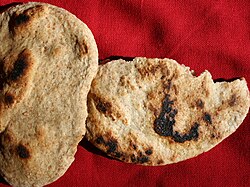Roti rata
Roti rata atau roti leper ialah roti yang dibuat dengan tepung, air dan garam, dan kemudian digulung menjadi adunan rata. Banyak roti rata yang tidak beragi—walaupun ada sedikit yang beragi, seperti roti pita. Sepanjang sejarah, banyak jika tidak kebanyakan budaya mempunyai makanan yang boleh dikelaskan sebagai roti rata.
| Roti rata | |
|---|---|
 Roti rata buatan sendiri | |
| Jenis | Roti |
| Bahan utama | Tepung, air, garam |
| sunting · sunting di Wikidata | |
Terdapat banyak ramuan pilihan lain yang boleh dicampur dalam pembuatan roti rata, seperti serbuk kari, potongan dadu jalapeño, serbuk cili, atau lada hitam. Minyak zaitun atau minyak bijan juga boleh ditambah. Roti rata boleh mempunyai ketebalan berjulat dari satu milimeter hingga beberapa sentimeter.
Sejarah sunting
Pada tahun 2018, serdak roti yang hangus ditemui di tapak Natufia yang dipanggil Shubayqa 1 di Jordan (Harrat ash Shaam, Gurun Hitam) yang berusia dari 12,400 SM, kira-kira 4000 tahun sebelum permulaan pertanian di rantau ini. Analisis menunjukkan bahawa ia mungkin dari roti rata yang mengandungi barli liar, gandum einkorn, oat, dan ubi Bolboschoenus glaucus.[1][2]
Lihat juga sunting
Rujukan sunting
- ^ Colin Barras (Jul 21, 2018). "Stone Age bread predates farming". New Scientist.
- ^ Amaia Arranz-Otaegui; dll. (Jul 16, 2018). "Archaeobotanical evidence reveals the origins of bread 14,400 years ago in northeastern Jordan". PNAS. doi:10.1073/pnas.1801071115. Explicit use of et al. in:
|last1=(bantuan)
Bacaan lanjut sunting
- 2005. "High-Profile Flatbreads - Say Goodbye to Insipid White Bread When Tortillas and Flatbreads Come to Town". FOOD PRODUCT DESIGN -NORTHBROOK-. 15, no. 1: 96-114. ISSN 1065-772X.
- 2008. "Flatbreads Old World: Meets New Flatbreads from All Over the World-Including Tortillas, Arepas and Naan-Are the Newest Hot Ticket in Both Retail and Foodservice Products". FOOD PRODUCT DESIGN -NORTHBROOK-. 18, no. 11: 38-43.
- 2008. "Storied Breads: With a Continuing Focus on Food Origin, Flatbreads Offer Manufacturers a Way to Tempt Consumers with Authentic Products Celebrating the Oldest-Known Bread Traditions". BAKING AND SNACK. 30, no. 7: 35-42. ISSN 1092-0447.
- 2010. "Glycaemic Index of Indian Flatbreads (Rotis) Prepared Using Whole Wheat Flour and Atta Mix-Added Whole Wheat Flour". British Journal of Nutrition. 103, no. 11: 1642-1647. ISSN 0007-1145.
- 2011. "Flat-Out in Love with Flatbread Here Are 5 Reasons Foodservice Is Smitten with Flatbreads". FOOD MANAGEMENT -NEW YORK THEN CLEVELAND OH-. 46, no. 11: 30-35. ISSN 0091-018X.
- Alford, Jeffrey, and Naomi Duguid. Flatbreads and Flavors: A Baker's Atlas. New York: W. Morrow, 1995. Summary: Recipes for more than sixty varieties of flatbreads along with 150 recipes for traditional accompaniments to the breads, including chutneys, curries, salsas, stews, mezze, smorgasbord, kebabs, etc.
- Craddock, Anne. Textural Characteristics of Bagels and Ethnic Flatbreads. 1998. Thesis. 124 leaves.
- German, Donna Rathmell. Flatbreads from Around the World. San Leandro, Calif: Bristol Pub, 1994.
- Hansen, Eric. 2015. "Fabled Flatbreads of Uzbekistan." Diarkibkan 2015-07-21 di Wayback Machine Aramco World. July/August 2015. Pages 32–39.
- Helou, Anissa. Savory Baking from the Mediterranean: Focaccias, Flatbreads, Rusks, Tarts, and Other Breads. New York: William Morrow, 2007.
- Kahlon, Talwinder Singh, and Mei-Chen Maggie Chiu. 2014. "Ancient Whole Grain Gluten-Free Flatbreads". Food and Nutrition Sciences. 05, no. 17: 1717-1724.
- Khawaja K.I., et al. 2012. "Glycaemic, Insulin and Ghrelin Responses to Traditional South Asian Flatbreads in Diabetic and Healthy Subjects". British Journal of Nutrition. 108, no. 10: 1810-1817.
- Reinhold, John G., Bahram Faraji, Parichehr Abadi, and Faramarz Ismail‐Beigi. 1981. "An Extended Study of the Effect of Iranian Village and Urban Flatbreads on the Mineral Balances of Two Men Before and After Supplementation with Vitamin D†". Ecology of Food and Nutrition. 10, no. 3: 169-177.
